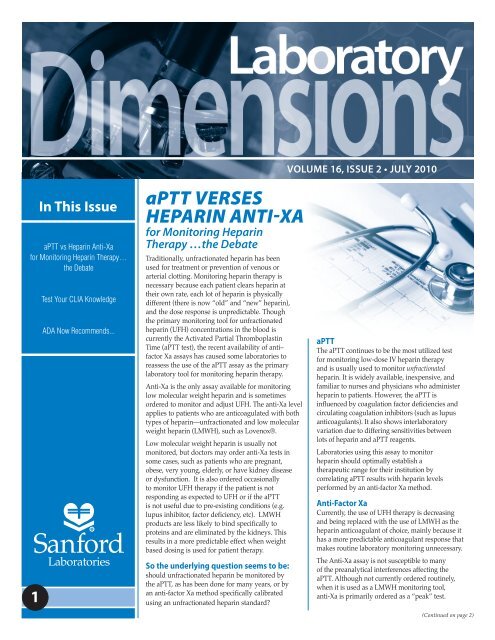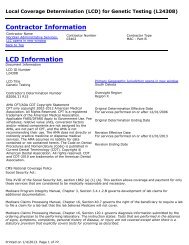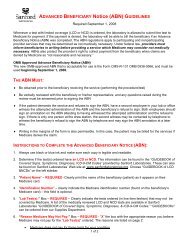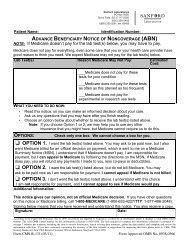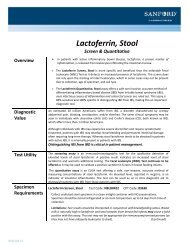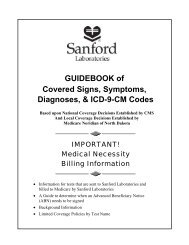aPTT VERSES HEPARIN ANTI-XA - Sanford Laboratories
aPTT VERSES HEPARIN ANTI-XA - Sanford Laboratories
aPTT VERSES HEPARIN ANTI-XA - Sanford Laboratories
You also want an ePaper? Increase the reach of your titles
YUMPU automatically turns print PDFs into web optimized ePapers that Google loves.
VOLUME 16, ISSUE 2 • JULY 2010<br />
<strong>aPTT</strong> vs Heparin Anti-Xa<br />
for Monitoring Heparin Therapy…<br />
the Debate<br />
1<br />
In This Issue<br />
Test Your CLIA Knowledge<br />
ADA Now Recommends...<br />
<strong>aPTT</strong> <strong>VERSES</strong><br />
<strong>HEPARIN</strong> <strong>ANTI</strong>-<strong>XA</strong><br />
for Monitoring Heparin<br />
Therapy …the Debate<br />
Traditionally, unfractionated heparin has been<br />
used for treatment or prevention of venous or<br />
arterial clotting. Monitoring heparin therapy is<br />
necessary because each patient clears heparin at<br />
their own rate, each lot of heparin is physically<br />
different (there is now “old” and “new” heparin),<br />
and the dose response is unpredictable. Though<br />
the primary monitoring tool for unfractionated<br />
heparin (UFH) concentrations in the blood is<br />
currently the Activated Partial Thromboplastin<br />
Time (<strong>aPTT</strong> test), the recent availability of anti–<br />
factor Xa assays has caused some laboratories to<br />
reassess the use of the <strong>aPTT</strong> assay as the primary<br />
laboratory tool for monitoring heparin therapy.<br />
Anti-Xa is the only assay available for monitoring<br />
low molecular weight heparin and is sometimes<br />
ordered to monitor and adjust UFH. The anti-Xa level<br />
applies to patients who are anticoagulated with both<br />
types of heparin—unfractionated and low molecular<br />
weight heparin (LMWH), such as Lovenox®.<br />
Low molecular weight heparin is usually not<br />
monitored, but doctors may order anti-Xa tests in<br />
some cases, such as patients who are pregnant,<br />
obese, very young, elderly, or have kidney disease<br />
or dysfunction. It is also ordered occasionally<br />
to monitor UFH therapy if the patient is not<br />
responding as expected to UFH or if the <strong>aPTT</strong><br />
is not useful due to pre-existing conditions (e.g.<br />
lupus inhibitor, factor deficiency, etc). LMWH<br />
products are less likely to bind specifically to<br />
proteins and are eliminated by the kidneys. This<br />
results in a more predictable effect when weight<br />
based dosing is used for patient therapy.<br />
So the underlying question seems to be:<br />
should unfractionated heparin be monitored by<br />
the <strong>aPTT</strong>, as has been done for many years, or by<br />
an anti-factor Xa method specifically calibrated<br />
using an unfractionated heparin standard?<br />
<strong>aPTT</strong><br />
The <strong>aPTT</strong> continues to be the most utilized test<br />
for monitoring low-dose IV heparin therapy<br />
and is usually used to monitor unfractionated<br />
heparin. It is widely available, inexpensive, and<br />
familiar to nurses and physicians who administer<br />
heparin to patients. However, the <strong>aPTT</strong> is<br />
influenced by coagulation factor deficiencies and<br />
circulating coagulation inhibitors (such as lupus<br />
anticoagulants). It also shows interlaboratory<br />
variation due to differing sensitivities between<br />
lots of heparin and <strong>aPTT</strong> reagents.<br />
<strong>Laboratories</strong> using this assay to monitor<br />
heparin should optimally establish a<br />
therapeutic range for their institution by<br />
correlating <strong>aPTT</strong> results with heparin levels<br />
performed by an anti-factor Xa method.<br />
Anti-Factor Xa<br />
Currently, the use of UFH therapy is decreasing<br />
and being replaced with the use of LMWH as the<br />
heparin anticoagulant of choice, mainly because it<br />
has a more predictable anticoagulant response that<br />
makes routine laboratory monitoring unnecessary.<br />
The Anti-Xa assay is not susceptible to many<br />
of the preanalytical interferences affecting the<br />
<strong>aPTT</strong>. Although not currently ordered routinely,<br />
when it is used as a LMWH monitoring tool,<br />
anti-Xa is primarily ordered as a “peak” test.<br />
(Continued on page 2)
ADVANTAGES/DISADVANTAGES<br />
OF APTT MONITORING<br />
Advantages<br />
• Inexpensive<br />
• Widely used as general screen<br />
• Long term use…”comfort zone”<br />
• Available 24/7 all labs<br />
Disadvantages<br />
• Relationship of heparin dose and<br />
heparin level not reliably predicted<br />
• Therapeutic <strong>aPTT</strong> with low heparin<br />
level = thromboembolism risk<br />
• Subtherapeutic <strong>aPTT</strong> with high<br />
heparin level = hemorrhage risk<br />
• <strong>aPTT</strong> does not reliably correlate to<br />
heparin blood concentration<br />
• <strong>aPTT</strong> does not reliably correlate to<br />
heparin antithrombotic effect<br />
• Variables—preanalytical, analytical, biologic<br />
• <strong>aPTT</strong> reagents vary in responsiveness to heparin<br />
• New therapeutic range with each<br />
lot of <strong>aPTT</strong> reagent (yearly)<br />
• New therapeutic range with any<br />
major change in <strong>aPTT</strong> system<br />
ADVANTAGES/DISADVANTAGES OF <strong>ANTI</strong>-<strong>XA</strong><br />
Advantages<br />
• Measures actual enzyme activity =<br />
reflection of heparin effect<br />
• Better correlation between anti-<br />
Xa activity and heparin level<br />
• More specific since it measures the<br />
inhibition of a single enzyme<br />
• Target better defined<br />
• 0.3–0.7 U/mL (UFH)<br />
• Fewer analytical errors<br />
Disadvantages<br />
• More expensive cost per test<br />
• Not available 24/7 in every lab<br />
• There is limited published information<br />
on the use of anti-Xa assays for routine<br />
monitoring of UFH therapy<br />
• Prompt sample processing (1 hour) is required to<br />
avoid heparin neutralization from platelet factor<br />
(Continued from page 1)<br />
It is collected when the blood level is at its highest level, about<br />
4 hours after a LMWH dose is given. Random and “trough”<br />
levels may be ordered if the doctor suspects that the patient<br />
may not be clearing the LMWH at a normal rate. In this case,<br />
the blood would be collected just prior to the next dose.<br />
A heparin level gives a quantitative result that can be compared<br />
to a therapeutic range (e.g. 0.3 to 0.7 units/mL) and is not<br />
affected by other conditions that prolong the <strong>aPTT</strong>.<br />
Principle of Anti-Factor Xa<br />
The activity of both UFH and LMWHs depends on binding to<br />
antithrombin. This binding induces a molecular change that<br />
dramatically accelerates its inhibitory activity. LMWHs primarily have<br />
anti-Xa activity while UFH has both anti-Xa and anti-IIa activity.<br />
The Xa inhibitory activity of antithrombin (AT) is increased in<br />
patients receiving either LMWH or UFH. This can be measured with<br />
a clotting-based assay or more commonly, a chromogenic assay.<br />
A standard curve is constructed by adding known amounts of LMWH or<br />
UFH to plasma and a fixed amount of Xa. This results in the formation of<br />
an inactive AT-Xa complex and the residual Xa is measured using either<br />
a clotting-based assay or chromogenic assay. The residual Xa activity is<br />
INVERSELY proportional to the concentration of heparin in the sample<br />
and may be quantitated from a calibration curve. The heparin used for<br />
preparation of the calibration curve should be the same heparin used<br />
for patient therapy at the institution, i.e., separate standard curves<br />
should be constructed for a specific UFH and a specific LMWH.<br />
(Continues on page 3)<br />
2
Test Your CLIA Knowledge<br />
1. How long does CLIA require the laboratory to retain test<br />
requisitions and authorizations?<br />
a. 1 year b. 2 years c. 3 years d. Indefinitely<br />
2. Which of the following activities is NOT included as part of<br />
the General Laboratory Systems?<br />
a. Patient confidentiality b. Specimen identification and integrity<br />
c. Specimen submission d. Proficiency testing performance<br />
3. What is the minimum quality control frequency for performing<br />
prothrombin times on an automated test system?<br />
a. 2 levels of control each day of patient testing<br />
b. 2 levels of control each day of patient testing<br />
and each time the reagent changes<br />
c. 2 levels of control every 8 hours<br />
d. 2 levels of control every 8 hours and each time the reagent is changed<br />
4. For unmodified FDA-cleared or approved, non-waived test system<br />
the laboratory must perform which of the following verification of<br />
performance steps before reporting patient test results?<br />
a. Accuracy and precision<br />
b. Accuracy, precision, reportable range, and reference range<br />
c. Accuracy, precision, reportable range, sensitivity,<br />
specificity, reportable range, and reference range<br />
d. None, just plug it in and away you go<br />
5. Which of the following test systems require calibration verification<br />
to be performed at a minimum of every 6 months?<br />
a. A chemistry analyzer that performs a daily 2 point calibration<br />
b. An automated cell counter with a minimum of 2 levels of<br />
control materials performed each day of patient testing<br />
c. A chemistry analyzer that performs a monthly 3 point calibration<br />
d. Both A and B<br />
6. Which subpart of the CLIA regulations are the Personnel Requirements<br />
found in?<br />
a. Subpart H b. Subpart J c. Subpart K d. Subpart M<br />
7. What is the minimum frequency for performing gram stain<br />
quality controls?<br />
a. Daily b. Weekly c. Each new lot of stain d. Both B and C<br />
8. Which of the following is considered a non-regulated proficiency<br />
testing analyte?<br />
a. Rubella b. Uric Acid c. TSH d. PSA<br />
9. Which of the following does NOT have to be included on a test report?<br />
a. Patient name and unique identifier<br />
b. Identity of the testing personnel<br />
c. Laboratory name and location<br />
d. Date when test results are reported as final<br />
10. A CLIA inspection could be conducted at a laboratory that has been<br />
issued a certificate of waiver or a certificate of provider-performed<br />
procedures under which of the following situations?<br />
a. To determine if the laboratory is operating and<br />
performing tests in a manner that does not constitute an<br />
imminent and serious risk to public health.<br />
b. To evaluate a complaint from the public.<br />
c. To determine whether the laboratory is performing tests beyond the<br />
scope of the certificate held by the certificate held by the laboratory.<br />
d. To collect information regarding the appropriateness of tests<br />
specified as waived tests or provider-performed<br />
microscopy procedures.<br />
e. All of the above.<br />
Trivia Game Answers: 1. B, 2. C, 3. D, 4. B, 5. A, 6. D, 7. D, 8. D, 9. B, 10. E<br />
Reference: http://www.uhl.uiowa.edu/publications/cliacorner/20102/2010q2.pdf<br />
(Continued from page 3)<br />
Conclusions<br />
Even though it is difficult to establish and maintain a validated<br />
therapeutic range with each reagent lot or instrument change, the <strong>aPTT</strong><br />
continues to be the test most often utilized by laboratories for monitoring<br />
IV heparin therapy. New challenges are arising in laboratories as<br />
LMWH and other new anticoagulants not requiring routine laboratory<br />
monitoring replace UFH. However, it is doubtful that UFH therapy will<br />
totally vanish anytime soon since there is a role for an anticoagulant<br />
whose effects can be rapidly reversed in the event of bleeding.<br />
The decision of whether to use the <strong>aPTT</strong> or a heparin level to monitor<br />
unfractionated heparin is probably best left to each institution,<br />
since it depends on patient population, local medical practices, and<br />
laboratory resources. <strong>Laboratories</strong> changing from using the <strong>aPTT</strong><br />
to a heparin level for monitoring UFH will need to work closely<br />
with their clinicians, pharmacists, and nurses to implement dosing<br />
algorithms that incorporate heparin levels. Also, heparin protocols for<br />
individual patients based on sex, age, height and weight should include<br />
monitoring the platelet count for heparin-induced thrombocytopenia/<br />
thrombosis, whether the <strong>aPTT</strong> or heparin level is used.<br />
Even though some institutions continue to use the <strong>aPTT</strong> to monitor<br />
routine heparin therapy, they may decide to also offer a heparin level<br />
for some patients with clinical conditions that do one of the following:<br />
1) prolong the baseline <strong>aPTT</strong>, 2) cause decreased sensitivity of the<br />
<strong>aPTT</strong> to heparin, or 3) show true heparin resistance (i.e., antithrombin<br />
deficiency, increased plasma binding/clearance of heparin).<br />
Reviewed by Mark Johnson, MD; LCM Pathologists, PC.<br />
References:<br />
1. http://www.cap.org/apps/cap.portal?_nfpb=true&cntvwrPtlt_<br />
actionOverride=/portlets/contentViewer/show&_windowLab<br />
el=cntvwrPtlt&cntvwrPtlt{actionForm.contentReference}=cap_<br />
today/0708/0708_qa.html&_state=maximized&_pageLabel=cntvwr<br />
2. http://practical-hemostasis.com/Miscellaneous%20Tests/anti-xa-assay.html<br />
3. http://www.labtestsonline.org/understanding/analytes/heparin/test.html<br />
4. http://peir.path.uab.edu/coag/printer_23.shtml<br />
5. Laboratory Monitoring of Heparin Therapy: Partial Thromboplastin Time<br />
or Anti-Xa Assay?, LabMedicine, Volume 40, Number 1, January 2009<br />
6. PowerPoint Presentation: Laboratory Monitoring of<br />
Unfractionated and Low Molecular Weight Heparin, Carol<br />
Lee Shearer CLS(NCA), MT(ASCP), Hemostasis Application<br />
Consultant – Region I, Siemens Healthcare Diagnostics<br />
3
ADDRESS SERVICE REQUESTED<br />
ADA Now Recommends HgbA1c to Diagnose<br />
and Screen for Diabetes<br />
4<br />
Each year the American Diabetic Association (ADA) updates its<br />
Standard of Care Recommendations. One significant change<br />
in the 2010 guidelines is the use of the Hemoglobin A1c<br />
(HgbA1c) assay to diagnose and screen for diabetes. While the<br />
ADA had previously recommended HbA1c only for monitoring<br />
of known diabetics, the ADA now endorses HgbA1c as one<br />
of the options to diagnose diabetes. Other recommended<br />
diagnostic tests include the fasting blood glucose, random<br />
blood glucose, and oral glucose tolerance tests.<br />
HgbA1c, which estimates average glucose levels over the<br />
past 3 months, is used to evaluate diabetic control over time.<br />
Previously, the ADA did not recommend the HgbA1c due to<br />
lack of assay standardization. They now believe that the test<br />
is well-monitored and reproducible in any chemistry platform<br />
certified by the National Glycohemoglobin Standardization<br />
Program (NGSP). Some Point of Care (POC) testing systems<br />
are not certified, however, so the lab should use caution when<br />
selecting testing equipment.<br />
The ADA recommends the following HgbA1c range<br />
guidelines: 1) Values near 5% indicate absence of diabetes,<br />
2) A range of 5.7% to 6.4% identifies increased risk for future<br />
diabetes, 3) > 6.5% diagnosis of diabetes<br />
The HgbA1c test does not require an overnight fast and<br />
while the test may not be as sensitive as the fasting blood<br />
glucose, the ease of testing may facilitate increased<br />
screening for diabetes. Hopefully this will encourage those<br />
in the prediabetic range to make positive lifestyle changes<br />
to ward off diabetes. For a complete review of the new<br />
Recommendations, see http://care.diabetesjournals.org/<br />
content/33/Supplement_1S11.full.<br />
Reviewed by Joel Ziebarth, MD; Associate Medical Director for<br />
<strong>Sanford</strong> <strong>Laboratories</strong>; LCM Pathologists, PC<br />
References:<br />
1. Summary of Revisions for the 2010 Clinical Practice<br />
Recommendation, Diabetes Care, Volume 33, Supplement 1, January<br />
2010.<br />
2. ADA now recommends HgA1c assay to diagnose, screen for<br />
diabetes. http://endocrinetoday.com/print.aspx?rid=59777; Accessed<br />
3/29/2010.<br />
3. American Diabetes Association Revises Diabetes Guidelines.<br />
http://www.medscape.com/viewarticle/714401. Accessed<br />
4/14/2010.


